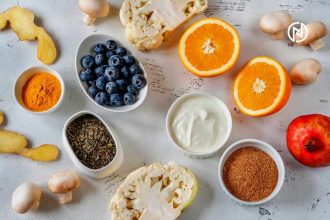Maintaining a healthy weight is essential for overall well-being and longevity. For men in India, achieving weight loss goals can be challenging due to factors like lifestyle, dietary habits, and cultural preferences. However, with the right approach and a well-designed diet plan, it is possible to shed those extra weight and improve your health. In this blog, we will guide you through an effective weight loss diet plan tailored specifically for Indian men.
- Emphasize Balanced Nutrition
A successful weight loss journey begins with a balanced and nutritious diet. Ensure that your meals comprise a healthy mix of macronutrients, including carbohydrates, proteins, and fats. Opt for complex carbohydrates such as whole grains, oats, and brown rice, which provide sustained energy and keep you feeling fuller for longer. Include lean sources of protein like chicken breast, fish, lentils, and low-fat dairy products. Healthy fats like nuts, seeds, avocados, and olive oil should also be a part of your diet.
2. Portion Control
Overeating is a common obstacle when it comes to weight loss. Be mindful of portion sizes to prevent excessive calorie intake. Use smaller plates to trick your brain into feeling satisfied with less food. Fill half your plate with vegetables, one-fourth with protein, and one-fourth with whole grains. This strategy will help you maintain a calorie deficit without compromising on essential nutrients.
3. Say Yes to Fiber
Fiber-rich foods are a boon for weight loss as they keep you satiated and aid in digestion. Include plenty of fruits and vegetables in your diet, such as spinach, broccoli, bell peppers, berries, and apples. Whole grains like quinoa, brown rice, and whole wheat bread are also excellent sources of fiber. These foods not only provide essential nutrients but also promote weight loss by curbing hunger pangs.
4. Include Indian Superfoods
Indian cuisine offers a wide range of nutritious superfoods that can boost weight loss. Include ingredients like turmeric, ginger, cinnamon, and garlic in your cooking as they have metabolism-boosting and anti-inflammatory properties. Spices like cumin, coriander, and fenugreek aid digestion and promote fat burning. Additionally, incorporate Indian staples like lentils (dal), yogurt (curd), and buttermilk (chaas) into your meals for their high protein content.
5. Healthy Snacking
Snacking can be a downfall for many individuals trying to lose weight. Instead of reaching for unhealthy options like chips or sweets, opt for healthier alternatives. Choose snacks like roasted chickpeas, almonds, roasted makhana (fox nuts), and Greek yogurt with fruits. These options provide essential nutrients, satiety, and help in keeping your calorie intake in check.
6. Hydration is Key
Staying hydrated is crucial for weight loss and overall health. Drink at least 8-10 glasses of water throughout the day. You can also include herbal teas, buttermilk, and coconut water for variety. Avoid sugary beverages, carbonated drinks, and excessive caffeine, as they can add unnecessary calories and hinder your progress.
7. Regular Physical Activity
While diet plays a significant role in weight loss, combining it with regular exercise is essential. Engage in activities you enjoy, such as jogging, swimming, cycling, or playing sports. Aim for at least 150 minutes of moderate-intensity aerobic exercise each week. Additionally, incorporate strength training exercises to build lean muscle mass, which helps in boosting metabolism and burn more calories.
8. Limit Processed Foods
Processed foods are often high in added sugars, unhealthy fats, and empty calories. These can sabotage your weight loss efforts. Minimize your consumption of packaged snacks, sugary beverages, fried foods, and sweets. Instead, focus on fresh, whole foods that are nutrient-dense and nourishing for your body.
9. Mindful Eating
Practicing mindful eating can significantly impact your weight loss journey. Slow down during meals, savor each bite, and pay attention to your body’s hunger and fullness cues. Avoid distractions such as television or smartphones while eating, as they can lead to overeating. Engaging in mindful eating allows you to enjoy your food and make healthier choices.
10. Meal Prepping
Preparing meals in advance can save time, reduce the likelihood of making unhealthy food choices, and help you stay on track with your weight loss goals. Dedicate some time each week to plan and prep your meals. Cook in bulk, portion out your meals, and store them in the refrigerator or freezer. This way, you’ll have healthy, homemade options readily available, minimizing the temptation to opt for unhealthy takeout or fast food.
11. Seek Support
Embarking on a weight loss journey can be challenging, but having a support system can make a significant difference. Share your goals with friends, family, or join support groups where you can find like-minded individuals who are also striving for a healthier lifestyle. You can exchange tips, share recipes, and motivate each other throughout the process.
12. Track Your Progress
Keeping track of your progress can be a great way to stay motivated and accountable. Monitor your weight regularly, but also consider other metrics such as body measurements, energy levels, and overall well-being. Celebrate your achievements, no matter how small, and make adjustments to your diet and exercise routine if necessary.
Conclusion
Losing weight requires dedication, discipline, and a holistic approach. With the right diet plan tailored to the Indian context and lifestyle, you can achieve your weight loss goals while still enjoying the flavors and diversity of Indian cuisine. Remember to consult with a healthcare professional or a registered dietitian before starting any new diet or exercise regimen, especially if you have any underlying health conditions.
Certainly! Here’s a sample weight loss diet plan for Indian men in a chart format. Please note that this is just a general guideline, and individual calorie and nutrient needs may vary. Adjust portion sizes and food choices based on your specific requirements and preferences.
Meal Time Food Groups Sample Options
Breakfast
7:00 AM
Protein + Whole Grains
2 boiled eggs, 1 small bowl of oatmeal with nuts and seeds
Mid-Morning Snack
10:00 AM
Fruits
1 apple or a bowl of mixed berries
Lunch
1:00 PM
Protein + Vegetables + Whole Grains
Grilled chicken breast, a portion of brown rice, mixed vegetables
Afternoon Snack
4:00 PM
Protein + Healthy Fats
Greek yogurt with chopped almonds and a sprinkle of cinnamon
Pre-Workout Snack
6:00 PM
Complex Carbohydrates
Whole wheat toast with peanut butter
Dinner
8:00 PM
Protein + Vegetables + Healthy Fats
Grilled fish, a serving of stir-fried vegetables, a small portion of quinoa
Evening Snack
10:00 PM
Light Protein
Sprouts salad or a glass of skimmed milk
General Guidelines
Drink at least 8-10 glasses of water throughout the day.
Include herbal teas, buttermilk, and coconut water as refreshing and hydrating options.
Adjust portion sizes based on your activity level and calorie needs.
Add spices like turmeric, cumin, coriander, and ginger for flavor and health benefits.
Aim for a calorie deficit but avoid extreme restrictions.
Remember, this is just a sample plan. Feel free to customize it based on your preferences, dietary restrictions, and individual needs. It’s always a good idea to consult with a registered dietitian for personalized guidance.
Good luck on your weight loss journey!














